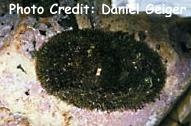
Mopalia mucosa
(Linnaeus, 1758)
Rock Chiton
Not Reef Tank Suitable
Not Suitable for Fish-Only Tank
More
Those animals in the Phylum Mollusca, (Mollusks (British spelling) or mollusks (American spelling)) are a large collection of animals, e.g., over 110,000 living species. They are known for their decorative shells and mantles such as clams and abalone, and/or squid, cuttlefish and octopus, which are one of the more intelligent invertebrates known to man.
Mollusks have a mantle, which is simply a fold of the outer skin lining the shell, and a muscular foot that is used for motion and/or securing the individual. In many species, the mantle produces a calcium carbonate external shell, and their gill extracts oxygen from the surrounding waters and also disposes of wastes. All have a complete digestive tract that begins with the mouth and terminates with the anus. There are many having a teeth-like structure for feeding, i.e., the radula, which is composed mostly of chitin. These 'structures' are used to scrape algae off rocks, and also in the harpoon-like structures of cone snails. Squid, octopus, and cuttlefish also possess a chitinous beak.
There are ten classes of mollusks; two consist of fossilized members, i.e., Rostroconchia and Helcionelloida; and Caudofoveara and Aplacophora that contain deep-sea worm-like creatures; and, Monoplacophora, which contains deep sea limpet-like creatures, and also Scaphopoda, which relates to Tusk Shells and all not of special interest to aquarists and divers. Therefore species in those six will not be discussed here. Those of more interest are:
Class Polyplacophora (chitons; 600 species, rocky marine shorelines)
Class Bivalvia (also Pelecypoda) (clams, oysters, scallops, mussels)
Class Gastropoda (nudibranchs, snails and slugs, limpets, sea hares; sea angel, sea butterfly, sea lemon)
Class Cephalopoda (squid, octopus, nautilus, cuttlefish)
And in this grouping, those of interest in the Class Polyplacophora and Class Gastropoda will be discussed.
Furthermore, there are some in this Grouping that show up in the aquarium trade, with none being photosynthetic, and most do well with gentle water movement.
Therefore, as noted in other areas of this Species Library, some species may contain suggested Water Motion (WM) recommended levels.
As for water motion, I've decided to relate it to the visible intensity of water motion on that of a long tentacle anemone. No visible tentacle motion is '0,' whereas a slight movement of some tentacles is '1.' If all the tentacles are gently swaying in the current it is '2.' If all tentacles are moving fairly fast and bouncing into each other it is '3.' Should all tentacles be driven with such force they are extended in one direction or unable to sway back to their central position it's '4.'
In this grouping you will see them listed as WM - X. Hopefully you'll find this quite helpful.

